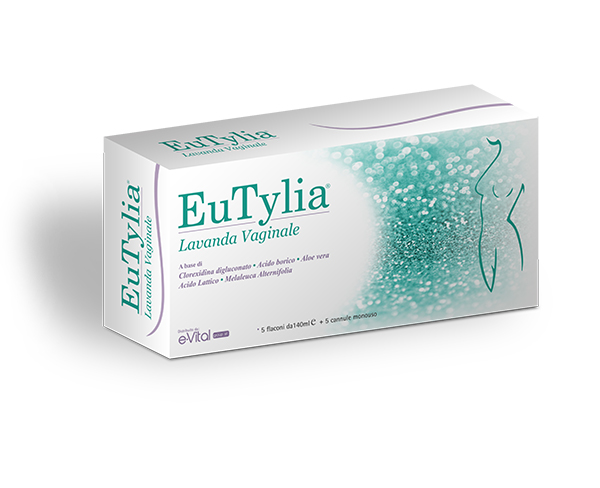EuTylia Vaginal Douche
- How to use
Vaginal irrigation can be done several times a day. It is preferable to apply EuTylia Vaginal Douche before going to sleep.
- Risk factors
The most common risk factors for intimate irritation are:
– reduction of vaginal pH
– lack of estrogen
– recurrent infections by germs (mycotic, bacterial or viral) – prolonged antibiotic therapies
– psychosomatic stress
- Active ingredients
Active Principles
Aqua
Sodium Benzoate Potassium sorbate
Glycerin
Boric Acid
Aloe Barbadensis Leaf Juice Lactic Acid
Chlorhecidine Digluconate Polysorbate 20
Melaleuca Alternifolia Oil Parfum
- Why EuTylia Vaginal Douche?
Eutylia Vaginal Douche is a medical device with a sanitizing, soothing and decongestant action. EuTylia Vaginal douche guarantees a protective action on the vaginal mucous thanks to its specific filmogenic and reparative properties that help restore the vaginal microbiota counteracting the attack of pathogenic microorganisms. It is indicated as adjuvant in the treatment and prevention of vaginitis and bacterial vaginosis, from infections of Candida and as a protective / soothing agent in irritative states of the vaginal mucosa.
EuTylia Vaginal Douche is a medical device containing boric acid , lactic acid and aloe created to restore vaginal physiological conditions (vaginal microbiota and pH rebalancing), which may be altered as a consequence of infections (cervicitis, vaginitis, vaginosis), prolonged antibiotic treatments or menopausal dryness.
EuTylia Vaginal Douche protects the integrity of the vaginal mucosa by making it more resistant to attacks by external pathogenic germs, it favors the physiological repair process of lesions of the mucous membranes (after sexual intercourse, in case of prolonged use of contraceptives, after invasive gynecological tests or gynecological interventions) and contrasts the annoying genital symptoms due to estrogen deficiency.
EuTylia Vaginal Douche has a formulation designed to ensure a deeper intimate hygiene leaving a pleasant and delicate fragrance and a freshness and clean feeling . It is useful in cases of vaginal dryness, as an adjuvant in the treatment of irritations, infections and intimate itching. Thanks to its soft and flexible cannula it can be used easily in any stage of a woman’s life. In order to minimize the risk of allergic or irritative phenomena, it does not contain dyes, non-greasy and does not stain.
- Bibliography
1)Hill GB (1993) The microbiology of bacterial vaginosis. Am J Obstet Gynecol 169:450-454 2. Culhane JF, Rauh V, McCollum KF, Hogan VK, Agnew K, Wadhwa PD (2001)
2) The association of psychosocial stress and bacterial vaginosis in a longitudinal cohort. Am J Obstet Gynecol 194(2):381-386 4. Petersen EE, Magnani P (2004)
3) Bacterial vaginosis. Prim Care Update Obgyns 7(5):181-185
4) SOGC Committee Opinion Bacterial vaginosis (1997). SOGC Clinical Practice Guidelines
5) Guaschino S. Benvenuti C. SOPHY Study Group
SOPHY Project: an observational study of vaginal pH and lifestyle in women of different ages and in different physiopathological conditions. Part I.
Minerva Ginecol. Apr; 60 (2): 105-14; 2008
6) Guaschino S. Benvenuti C. SOPHY Study Group
SOPHY project: an observational study of vaginal pH, lifestyle and correct intimate hygiene in women of different ages and in different physiopathological conditions. Part II.
Minerva Ginecol. Oct; 60 (5): 353-62. 2008
